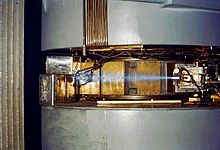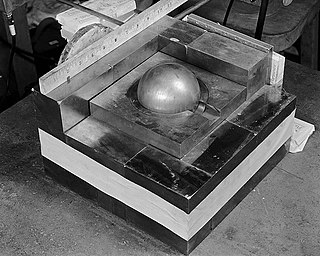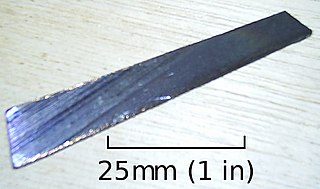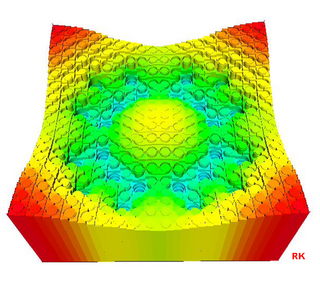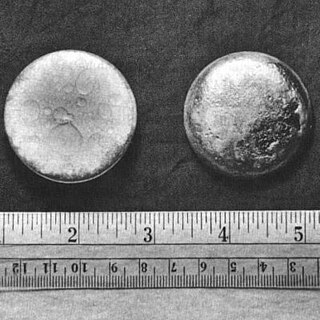Known incidents
A Los Alamos report (McLaughlin et al. [1] ) recorded 60 criticality accidents between 1945 and 1999. These caused 21 deaths: seven in the United States, ten in the Soviet Union, two in Japan, one in Argentina, and one in Yugoslavia. Nine have been due to process accidents, and the others from research reactor accidents. Criticality accidents have occurred in the context of production and testing of fissile material for both nuclear weapons and nuclear reactors.
The table below gives a selection of well documented incidents, including some not included in the report by McLaughlin et al.
| Date | Location | Description | Injuries | Fatalities | Refs |
|---|---|---|---|---|---|
| 1944 | Los Alamos | Otto Frisch received a larger than intended dose of radiation when leaning over the original Lady Godiva device for a couple of seconds. He noticed that the red lamps (that normally flickered intermittently when neutrons were being emitted) were "glowing continuously". Frisch's body had reflected some neutrons back to the device, increasing its neutron multiplication, and it was only by quickly leaning back and away from the device and removing a couple of the uranium blocks that Frisch escaped harm. Afterwards he said, "If I had hesitated for another two seconds before removing the material ... the dose would have been fatal". On 3 February 1954 and 12 February 1957, accidental criticality excursions occurred, causing damage to the device but only insignificant exposures to personnel. This original Godiva device was irreparable after the second accident and was replaced by the Godiva II. | 0 | 0 | [5] [6] |
| 4 June 1945 | Los Alamos | Scientist John Bistline was conducting an experiment to determine the effect of surrounding a sub-critical mass of enriched uranium with a water reflector. The experiment unexpectedly became critical when water leaked into the polyethylene box holding the metal. When that happened, the water began to function as a highly effective moderator rather than just a neutron reflector. Three people received non-fatal doses of radiation. | 3 | 0 | [7] |
| 21 August 1945 | Los Alamos | Scientist Harry Daghlian suffered fatal radiation poisoning and died 25 days later after accidentally dropping a tungsten carbide brick onto a sphere of plutonium, which was later (see next entry) nicknamed the demon core. The brick acted as a neutron reflector, bringing the mass to criticality. This was the first known criticality accident causing a fatality. | 0 | 1 | [8] [9] |
| 21 May 1946 | Los Alamos | Scientist Louis Slotin accidentally irradiated himself during a similar incident (called the "Pajarito accident" at the time) using the same "demon core" sphere of plutonium involved in the Daghlian accident. Slotin surrounded the plutonium sphere with two 9-inch diameter hemispherical cups of the neutron-reflecting material beryllium, one above and one below. He was using a screwdriver to keep the cups slightly apart and the assembly thereby subcritical, contrary to normal protocols. When the screwdriver accidentally slipped, the cups closed around the plutonium, sending the assembly supercritical. Slotin quickly disassembled the device, likely sparing others in the room from lethal exposure, but Slotin himself died of radiation poisoning nine days later. The demon core was melted down and the material was reused in other bomb tests in subsequent years. [10] | 8 | 1 | [11] [12] |
| 16 June 1958 | Oak Ridge, Tennessee | The first recorded uranium-processing–related criticality occurred at the Y-12 Plant. During a routine leak test a fissile solution was unknowingly allowed to collect in a 55-gallon drum. The excursion lasted for approximately 20 minutes and resulted in eight workers receiving significant exposure. There were no fatalities, though five were hospitalized for 44 days. All eight workers eventually returned to work. | 8 | 0 | [13] [14] |
| 15 October 1958 | Vinča Nuclear Institute | A criticality excursion occurred in the heavy water RB reactor at the Boris Kidrič Nuclear Institute in Vinča, Yugoslavia, killing one person and injuring five. The initial survivors received the first bone marrow transplant in Europe. | 5 | 1 | [15] [16] [17] |
| 30 December 1958 | Los Alamos | Cecil Kelley, a chemical operator working on plutonium purification, switched on a stirrer on a large mixing tank, which created a vortex in the tank. The plutonium, dissolved in an organic solvent, flowed into the center of the vortex. Due to a procedural error, the mixture contained 3.27 kg of plutonium, which reached criticality for about 200 microseconds. Kelley received 3,900 to 4,900 rad (36.385 to 45.715 Sv) according to later estimates. The other operators reported seeing a bright flash of blue light and found Kelley outside, saying "I'm burning up! I'm burning up!" He died 35 hours later. | 0 | 1 | [18] |
| 3 January 1961 | SL-1, 40 miles (64 km) west of Idaho Falls | SL-1, a United States Army experimental nuclear power reactor underwent a steam explosion and core disassembly due to improper manual withdrawal of the central control rod, killing its three operators by explosion force and impaling. | 0 | 3 | [19] |
| 24 July 1964 | Wood River Junction | The facility in Richmond, Rhode Island was designed to recover uranium from scrap material left over from fuel element production. Technician Robert Peabody, intending to add trichloroethene to a tank containing uranium-235 and sodium carbonate to remove organics, added uranium solution instead, producing a criticality excursion. The operator was exposed to a fatal radiation dose of 10,000 rad (100 Gy). Ninety minutes later a second excursion happened when a plant manager returned to the building and turned off the agitator, exposing himself and another administrator to doses of up to 100 rad (1 Gy) without ill effect. The operator involved in the initial exposure died 49 hours after the incident. | 0 | 1 | [20] [21] [22] |
| 10 December 1968 | Mayak | The nuclear fuel processing center in central Russia was experimenting with plutonium purification techniques using different solvents for solvent extraction. Some of these solvents carried over to a tank not intended to hold them, and exceeded the fissile safe limit for that tank. Against procedure a shift supervisor ordered two operators to lower the tank inventory and remove the solvent to another vessel. Two operators were using an "unfavorable geometry vessel in an improvised and unapproved operation as a temporary vessel for storing plutonium organic solution"; in other words, the operators were decanting plutonium solutions into the wrong type—more importantly, shape—of container. After most of the solvent solution had been poured out, there was a flash of light and heat. "Startled, the operator dropped the bottle, ran down the stairs, and from the room." After the complex had been evacuated, the shift supervisor and radiation control supervisor re-entered the building. The shift supervisor then deceived the radiation control supervisor and entered the room of the incident; this was followed by the third and largest criticality excursion that irradiated the shift supervisor with a fatal dose of radiation, possibly due to an attempt by the supervisor to pour the solution down a floor drain. | 1 | 1 | [23] |
| 23 September 1983 | Centro Atomico Constituyentes | An operator at the RA-2 research reactor in Buenos Aires, Argentina, received a fatal radiation dose of 3700 rad (37 Gy) while changing the fuel rod configuration with moderating water in the reactor. Two others were injured. | 2 | 1 | [24] [25] |
| 10 August 1985 | Chazhma Bay, Vladivostok | The reactor tank lid of the nuclear powered Soviet submarine K-431 was being replaced, after it had been refuelled. The lid was laid incorrectly and had to be lifted again with the control rods attached. A beam was supposed to prevent the lid from being lifted too far, but this beam was positioned incorrectly, and the lid with control rods was lifted up too far. At 10:55 AM the starboard reactor became prompt critical, resulting in a criticality excursion of about 5·1018 fissions and a thermal/steam explosion. The explosion expelled the new load of fuel, destroyed the machine enclosures, ruptured the submarine's pressure hull and aft bulkhead, and partially destroyed the fuelling shack, with the shack's roof falling 70 metres away in the water. A fire followed, which was extinguished after 4 hours, after which assessment of the radioactive contamination began. There were ten fatalities and 49 other people suffered radiation injuries, and a large area northwest across the Dunay Peninsula was severely contaminated. | 49 | 10 | [26] |
| 17 June 1997 | Sarov | Russian Federal Nuclear Center senior researcher Alexandr Zakharov received a fatal dose of 4850 rem in a criticality accident. | 0 | 1 | [27] [28] [29] |
| 30 September 1999 | Tōkai | At the Japanese uranium reprocessing facility in Ibaraki Prefecture, technicians working on producing fuel for the Jōyō fast reactor poured a uranyl nitrate solution into a precipitation tank which was not designed to hold a solution of this uranium enrichment, causing an eventual critical mass to be formed, resulting in the death of two workers from severe radiation exposure. | 1 | 2 | [30] [31] [32] |
- The sphere of plutonium surrounded by neutron-reflecting tungsten carbide blocks in a re-enactment of Harry Daghlian's 1945 experiment [33]
- A re-creation of the Slotin incident. The plutonium "demon core" (the same as in the Daghlian incident) was inside at the time of the accident, and would not be visible.
- Lady Godiva assembly in the scrammed (safe) configuration [34]
- Lady Godiva assembly, with damaged supporting rods after the excursion of February 1954. Note the images are of different assemblies. [34]
There was speculation although not confirmed within criticality accident experts, that Fukushima 3 suffered a criticality accident. Based on incomplete information about the 2011 Fukushima I nuclear accidents, Dr. Ferenc Dalnoki-Veress speculates that transient criticalities may have occurred there. [35] Noting that limited, uncontrolled chain reactions might occur at Fukushima I, a spokesman for the International Atomic Energy Agency (IAEA) "emphasized that the nuclear reactors won't explode." [36] By 23 March 2011, neutron beams had already been observed 13 times at the crippled Fukushima nuclear power plant. While a criticality accident was not believed to account for these beams, the beams could indicate nuclear fission is occurring. [37] On 15 April, TEPCO reported that nuclear fuel had melted and fallen to the lower containment sections of three of the Fukushima I reactors, including reactor three. The melted material was not expected to breach one of the lower containers, which could cause a massive radioactivity release. Instead, the melted fuel is thought to have dispersed uniformly across the lower portions of the containers of reactors No. 1, No. 2 and No. 3, making the resumption of the fission process, known as a "recriticality", most unlikely. [38]




